Monitoring Livestock Vital Signs
ID
APSC-169NP (APSC-210NP)
Introduction
Taking temperature, pulse rate, and respiration readings can help you gauge an animal’s overall health. In general, abnormal readings in animal blood pressure, pulse rate, temperature, and vital signs could indicate a larger problem. Monitoring livestock vital signs can help you identify potential issues early so you can contact your veterinarian for further diagnosis. Your veterinarian may also ask you to measure and report vital signs when you call for assistance in the event of an emergency, illness, or injury.
Monitoring an Animal’s Temperature
To determine whether your animal's body temperature is normal, follow these steps to take a temperature reading.
- Use a veterinary thermometer—conventional and digital types are acceptable.
- Tie a long string securely to the end of the thermometer.
- Moisten or lubricate the end of the thermometer.
- Insert the thermometer into the rectum (figure 1). Ensure that the thermometer does not get pulled into the rectum or broken; the string provides a backup means for removal. For horses, you may clip the thermometer string onto a portion of the tail.
- Remove in 2 to 3 minutes and read or use the time interval recommended by the manufacturer.
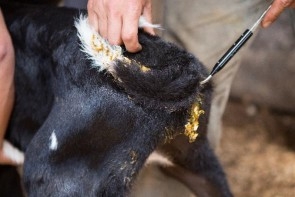
Interpreting Thermometer Readings
Be mindful that external temperatures can influence thermometer readings. Similarly, a healthy animal may appear to have a fever after a period of activity, for example, a horse shortly after it is ridden, or cattle after they are moved or worked on a hot day. If a resting animal has an abnormally high body temperature apart from normal fluctuation and environmental conditions, this may indicate that the animal is fighting an infection or suffering from heatstroke. This is known as "having a fever" in humans. When temperature deviates by one degree from the normal range, the animal is considered to have a fever. Abnormally low temperature readings occur less often and can indicate problems but can also be the result of external factors and normal fluctuation.
| Animal | Normal Rectal Temperature Range (ºF) |
|---|---|
| Cattle | 100.4-103.1 |
| Sheep and Goats | 102.2-104.9 |
| Swine | 100.4-104 |
| Horses | 99.5-101.3 |
| Foals | 99.5.0-102.2 |
Values taken from Vital Signs in Animals: What Cattle Producers Should Know About Them, LeViness, University of Arizona, publication number BCH-3000
Monitoring an Animal’s Pulse
For each species, use a stopwatch to measure pulses that occur in one minute (60 seconds). Use gentle, steady pressure to palpate the artery (figure 2) and count pulses. Ensure that you do not palpate and measure using your thumb, as you may interpret your own pulse as that of the animal’s. If you have a stethoscope available, you may also be able to listen for a pulse on the left side of an animal’s chest, just behind the elbow or at what is considered the “girth line” on a horse
Cattle
The external maxillary artery crosses the lower edge of the jaw, just in front of the masseter (cheek) muscle. When you place your fingers flat on the cheek in front of the masseter muscle and move them back and forth, you can easily feel the artery.
Sheep and Goats
Place your hand on the inside of the animal's thigh—the saphenous artery runs down the inside of the hind leg.
Swine
In swine, the heart must be palpated directly to feel a pulse. Researchers and others sometimes use heart rate monitoring devices when measuring heart rates in swine.
Horses
As with cattle, the external maxillary artery crosses the lower edge of the jaw, just in front of the masseter (cheek) muscle. When you place your fingers flat on the cheek in front of the masseter muscle and move them back and forth, you can easily feel the artery. You can also measure pulse on a horse on the left side of the chest, just under the elbow, in which case it may be helpful to ask the horse to step a bit forward on the left side. Some horse owners measure the digital pulse—this can be felt on the back of the pastern above the coronary band or just above the pastern joint. However, digital pulse can be more difficult to locate than the pulse behind the elbow or on the edge of the jaw. This reading is used by some horse owners to indicate possible cases of laminitis, as a horse with laminitis may experience a throbbing digital pulse.
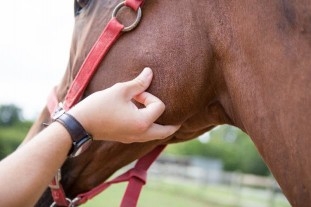
Interpreting Pulse Measurements
Pulse can vary from the listed normal ranges for a number of reasons, including recent exercise or activity, animal age, size, external conditions, and more. However, a pulse rate that falls outside of the normal range for your animal at rest can be indicative of a problem and pulse rate may be useful information to provide to a veterinarian in case of an emergency.
Table 2. Normal Animal Pulse Rate by Species
| Animal | Heart Beats per Minute |
|---|---|
| Cattle | 40-70 |
| Sheep and Goats | 60-90 |
| Swine | 60-100 |
| Horses | 28-40 |
| Foals | 100 for newborn foals; 45-60 for weanlings and yearlings |
Values taken from Vital Signs in Animals: What Cattle Producers Should Know About Them, LeViness, University of Arizona, publication number BCH-3000
Monitoring an Animal’s Respiration Rate
For most animals, you may observe or palpate the rise and fall of the animal’s flank, using a stopwatch to take a count of breaths over the course of one minute (figure 3). You may also observe breaths at the nostrils (figure 4). Take note of any wheezing, rattling, groaning, or noisy breaths and try to determine if breathing is non-rhythmic, labored, or shallow.
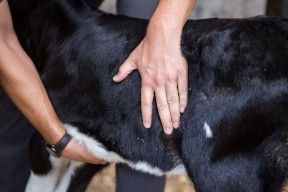
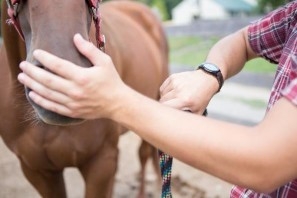
Interpreting Respiration Rates
Measure respiration rate when your animal is at rest. Respiration rate is influenced by stress, exercise, temperature, and more. Labored, shallow, or noisy respiration can indicate problems. Abnormal respiration may indicate pain or stress, and a number of livestock diseases are associated with abnormal respiration.
Table 3. Normal Resting Respiration Rate by Species
| Animal | Breaths per Minute |
|---|---|
| Cattle | 10-30 (beef); 18-28 (dairy) |
| Sheep and Goats | 12-20 |
| Swine | 8-18 |
| Horses | 8-16 |
Values taken from Vital Signs in Animals: What Cattle Producers Should Know About Them, LeViness, University of Arizona, publication number BCH-3000 and adapted from CATTLE PRODUCER’S LIBRARY CL610
Other Vital Signs
Animals can become dehydrated, particularly in the summer or when they are experiencing stress or illness. You can perform a skin pinch test to check for signs of dehydration (figure 5). Typically, this is done on the skin of the neck—pinch up a tent of skin between your thumb and forefinger, hold it for a few seconds, and release it. The skin should return to its place in one to two seconds. You may combine this with an assessment of the gums or nose. Gums and mucous membranes should be moist, not dry.

You can also assess capillary refill time. A horse or other animal with abnormal gum color and abnormal capillary refill time may be in shock or may be bleeding internally. Gums should appear medium pink in color, not whitish or red (figure 6). If you lift the lip and press a finger against the gums, color should return to the area within one to three seconds of releasing your finger.
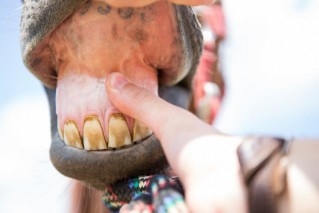
You can gain a more complete picture of your animal’s health by observing behavior, bowel movements, eating habits, skin and hair condition, and body condition. Are calves alert, or do they appear depressed with drooping ears? Can you observe gut sounds when your horse appears in distress? Has your animal refused food and water? Has it urinated more or less frequently than usual? Does your animal have a poor, unthrifty hair coat? These observations can all be an important part of the animal health puzzle. While pulse, temperature, and respiration rate are most commonly measured and reported as part of an animal emergency, these other animal health observations can be helpful as you consider your rations, health protocols, facilities, and other management factors that impact short-term and long-term animal health.
Adapted from:
“Vital Signs in Animals: What Cattle Producers Should Know About Them,” Edward A. LeViness, Area livestock Specialist, University of Arizona, publication number BCH-3000.
“Livestock Care Guidelines,” University of Arkansas Department of Animal Science, publication MP 520.
“Cattle First Aid, Basic Care, and Common Diseases in Show Cattle,” Karah Nay, Matthew Garcia, Kerry Rood, DVM, and Chelsea Walker, Utah State University online workbook.
Equine Science, Jean T. Griffiths, published by Equine Network 2008.
Acknowledgments
Special thanks to Elijah Griles for assistance creating the photos for this publication and Dr. Sherrie Clark-Deener, DVM, Virginia-Maryland College of Veterinary Medicine, for assistance by making suggestions to improve this document. Thank you to Laura Siegle, former Extension Agent, Amelia County, Virginia Tech, who co-authored the original publication.
Virginia Cooperative Extension materials are available for public use, reprint, or citation without further permission, provided the use includes credit to the author and to Virginia Cooperative Extension, Virginia Tech, and Virginia State University.
Virginia Cooperative Extension is a partnership of Virginia Tech, Virginia State University, the U.S. Department of Agriculture (USDA), and local governments, and is an equal opportunity employer. For the full non-discrimination statement, please visit ext.vt.edu/accessibility.
Publication Date
May 29, 2025



